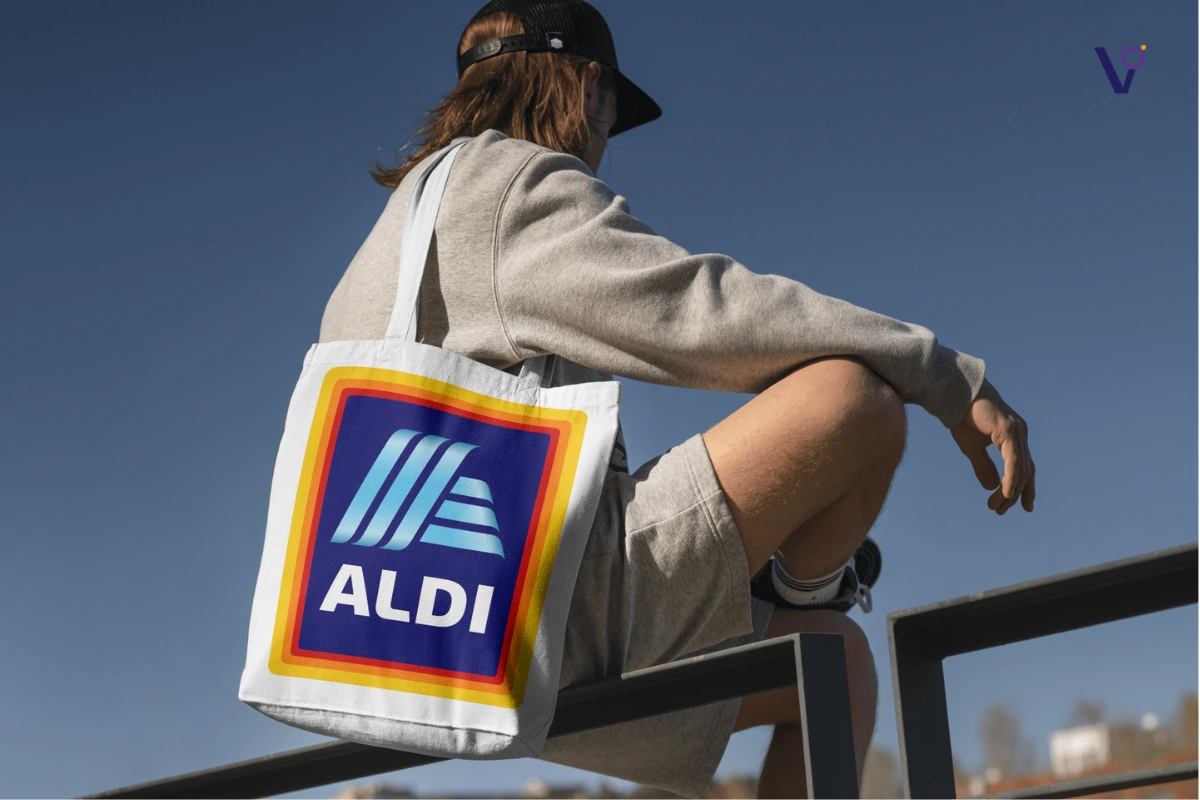When you step into an Aldi, it’s quickly apparent this isn’t your average supermarket. No café in the store, no deli counter, and no flower department greeting you at the door. What you’ll get, however, is half a gallon of regular whole milk for $2.18, a dozen eggs for $1.87, and a loaf of bread for $1.29 — all prices that have caused Aldi to become one of the quickest-growing supermarket chains in the U.S. as a result of Aldi’s marketing strategy emphasis and thrift.
Behind those low prices lies a strategy founded on simplicity, efficiency, and savvy marketing psychology. Aldi is not merely selling groceries; it’s selling a value story and a story of smart shopping — a story that strongly appeals, particularly in times of economic instability.
Let us disassemble Aldi’s marketing strategy.
1. Simplicity
Here’s how Aldi’s marketing strategy stands out:

- From a marketing perspective, Aldi’s no-frills approach isn’t just about saving operational costs — it’s about reinforcing its brand identity.
- Aldi stores average around 12,000 square feet, significantly smaller than conventional supermarkets, and are intentionally designed for speed and simplicity.
- The ability to see all four walls of the store upon entry reduces shopper stress and reinforces Aldi’s brand promise of an efficient, hassle-free grocery run.
- Unlike traditional supermarkets that offer around 31,000 products, Aldi stocks just 1,600 carefully selected items.
- The limited product range, with items left in the boxes they arrive in, not only reduces labor costs but also aligns with Aldi’s identity as a discount grocery leader.
- This deliberate minimalism signals to customers that every operational decision is made to cut costs and pass the savings on.
- From a marketing standpoint, this strategy works because it builds trust.
- Consumers can physically see how the store is cutting expenses — from having customers deposit a quarter for a cart to charging for grocery bags.
- These visible savings reinforce Aldi’s brand message: low prices without sacrificing quality.
- Ultimately, this reflects the heart of Aldi’s Marketing Strategy — keeping operations simple, costs low, and trust high.
2. Aldi’s Price Perception

One of the most successful Aldi marketing strategies is its emphasis on Known Value Items (KVIs) — everyday products such as milk, eggs, and bread whose costs consumers are used to recalling. By setting the prices on these staples substantially below the competition, Aldi conditions consumers to think that the entire store contains a better value.
Competitors feel the pressure the moment Aldi enters a new market. Local retailers often react by slashing their own prices on similar staple products. It’s not just a pricing war; it creates a marketing ripple effect. Aldi uses these lower prices as strategic loss leaders to drive more people into its stores, knowing that once shoppers are inside, they’ll likely pick up plenty of other items too.
The beauty of Aldi’s marketing strategy lies in how it uses KVIs to anchor its value proposition. There’s no need for expensive advertising campaigns or complicated loyalty programs. The prices themselves do the talking — a clear, honest approach that speaks to shoppers in the simplest way possible.
3. Aldi’s Private Labels
Aldi’s product lineup is dominated by private labels, accounting for around 90% of its inventory. But unlike traditional store brands, which often carried a stigma of being lower quality, Aldi’s private labels are designed to mirror national brand favorites both in appearance and taste — at a fraction of the price.
From a marketing perspective, this is genius. It taps into consumer behavior known as substitutability bias — the tendency to believe a near-identical product offers the same experience, especially if the packaging and product category are familiar. Aldi’s Thin Wheat crackers sit beside Wheat Thins equivalents, not as a budget compromise, but as a smart shopper’s choice.
In recent years, when inflation and economic pressure had grown, private-label products in the entire grocery business experienced a surge. From 2018 through 2022, there was a 34% increase in sales of private label products to more than $57 billion.. Aldi didn’t just ride this wave — it led it.
Aldi’s private label strategy positions it uniquely: not as a place for cheap generics, but as a store offering exclusive products of equivalent or better quality than national brands. This repositioning has expanded Aldi’s appeal beyond budget-conscious shoppers to include busy families, young professionals, and health-conscious consumers — audiences traditionally loyal to premium grocery chains.
4. Consumer Strategy
Aldi’s growth isn’t accidental; it thrives in tough economic climates. The 2008 financial crisis sparked an aggressive expansion strategy of opening around 100 new stores per year. Remarkably, even as the economy recovered, Aldi not only retained its recession-era customers but kept growing its customer base.
From a marketing angle, Aldi understands how to turn external economic conditions into opportunities. When inflation started straining household budgets, Aldi didn’t just promote its low prices; it reinforced a brand narrative around smart, efficient shopping. This shift was subtle but effective — Aldi was no longer just for bargain hunters but for anyone valuing their time, money, and common sense.
Aldi also markets itself through customer experience rather than traditional advertising. Shoppers become brand advocates, sharing their savings stories and finds on social media, effectively turning everyday customers into a grassroots marketing force. This organic word-of-mouth marketing keeps acquisition costs low while building a loyal community of value-seekers.
Conclusion
Aldi has turned operational efficiency into its most powerful marketing tool. Every element — from store layout to private label packaging — serves both cost-saving and brand-building functions. Rather than depending on their overuse of garish commercials, Aldi allows their low prices, recognized value merchandise, and efficient shopping experience promote the brand for them.
As consumer expectations evolve and economic pressures persist, Aldi’s model offers a compelling blueprint for how simplicity and consistency can drive brand loyalty and market share. Marketing success isn’t built on elaborate campaigns but on a clear, authentic message: great groceries don’t have to come with a high price tag or a complicated shopping trip.
And in today’s world, that’s a message that sells.
Aldi’s marketing strategy emphasizes simplicity, efficiency, and cost leadership, offering high-quality private-label products at low prices through streamlined operations and minimalistic store layouts.
Aldi’s main focus is delivering high-quality products at the lowest possible prices, achieved through operational efficiency, private labeling, and a no-frills shopping experience.
The five market entry strategies are: Exporting, Licensing, Franchising, Joint Ventures, and Direct Investment, each varying in risk, control, and investment levels.



